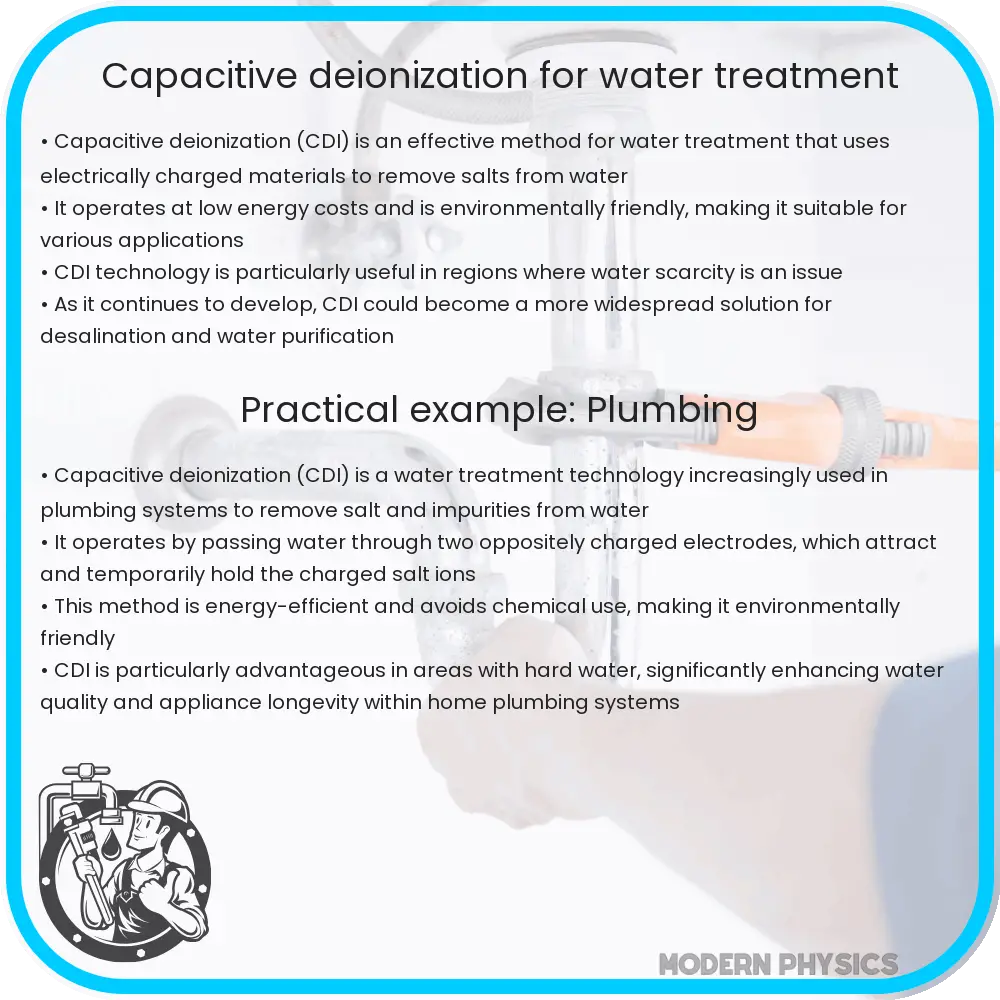Explore Capacitive Deionization: an eco-friendly, cost-effective water purification method. Learn about its efficiency, advancements, and future prospects.

Understanding Capacitive Deionization (CDI)
Capacitive Deionization (CDI) is an innovative water treatment technology that offers an efficient, cost-effective, and eco-friendly solution to water purification. This method uses electrical energy to remove ions, such as salt, from water, making it an ideal alternative to conventional water desalination and purification processes.
How CDI Works
CDI operates on a simple principle. It involves passing water through an electrochemical cell containing two oppositely charged electrodes, typically made of carbon. When a voltage is applied, ions in the water are attracted and adhere to the surface of these electrodes. Positively charged ions, or cations, move towards the cathode, while negatively charged ions, or anions, are attracted to the anode. This process effectively removes these ions from the water, resulting in purified water.
Advantages of CDI
- Energy Efficiency: CDI requires relatively low energy compared to traditional desalination techniques like reverse osmosis. This is because it operates at a lower pressure and does not require phase changes or significant heat input.
- Environmentally Friendly: CDI produces less waste and does not rely on chemicals for water treatment, making it a more environmentally sustainable option.
- Cost-Effectiveness: The operational and maintenance costs of CDI systems are generally lower than those of conventional water treatment methods.
Applications of CDI
CDI technology has a wide range of applications. It is particularly useful in areas where water scarcity is a significant issue. CDI systems can be used for:
- Desalinating brackish water or seawater for drinking and agricultural purposes.
- Removing harmful ions like lead (Pb2+) and arsenic (As3+ or As5+) from contaminated water sources.
- Treating industrial wastewater to remove heavy metals and other pollutants.
Challenges and Future Prospects
Despite its advantages, CDi faces some challenges. The efficiency of CDI systems can be affected by factors like water composition and flow rate. Research is ongoing to improve electrode materials and system design for better performance and broader application. With advancements in technology, CDI is expected to become an even more vital tool in global water treatment efforts, contributing significantly to sustainable water management.
Enhancing CDI Efficiency and Sustainability
To maximize the efficiency of Capacitive Deionization, ongoing research focuses on improving electrode materials and design. Advanced materials like graphene and carbon nanotubes are being explored for their superior conductivity and increased surface area, which can enhance ion adsorption. Additionally, optimizing the pore size distribution in electrode materials can significantly increase the efficiency of ion removal.
Integrating Renewable Energy Sources
Another exciting development in CDI technology is its integration with renewable energy sources. Solar-powered CDI systems, for instance, are being developed to provide clean water in remote and off-grid locations. This integration not only enhances the eco-friendliness of the system but also ensures its operability in areas without reliable access to electricity.
Scaling Up for Wider Adoption
Scaling up CDI technology for wider adoption is crucial. Currently, most CDI systems are suitable for small to medium-scale applications. Efforts are underway to design large-scale systems that can cater to the needs of urban water treatment facilities and industrial applications. Overcoming these scalability challenges is key to making CDI a mainstream technology in water treatment.
Conclusion
Capacitive Deionization represents a paradigm shift in water purification technology. Its low energy consumption, minimal environmental impact, and cost-effectiveness position it as a promising solution to global water challenges. While there are hurdles to overcome, such as enhancing efficiency and scalability, the integration of advanced materials and renewable energy sources paints a hopeful future. As we continue to refine and develop this technology, CDI stands out as a beacon of sustainable water management, offering a brighter, cleaner future for our planet’s most precious resource – water.
